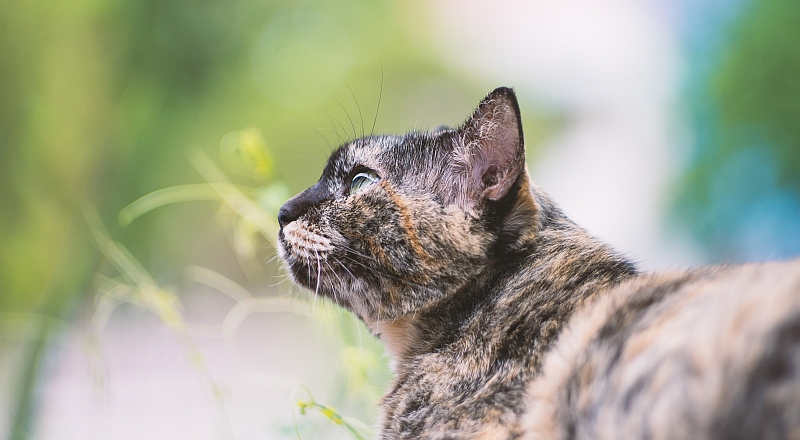Lifespan is often a question that comes up when someone is considering a new pet. Some people are concerned, about the length of commitment that will have to be made, and others worry about losing their new friend sooner than they imagine. Either way, the question is an important one for new pet owners to ask.
The lifespan of a cat depends on a variety of factors, including breed, type of living conditions, and quality of care.
Breed is a major predictor as to how long a cat can be expected to live, so we have included a table below for quick reference; however, we will also discuss other factors that can impact the life expectancy of a cat.
Indoor vs Outdoor Cat Life Expectancy
Indoor cats are generally expected to live a longer life, as they are less likely to encounter situations that may result in passing earlier than they would have otherwise. Though just the act of living outdoors (full time or part time) does not in itself dictate the length of a cat’s life, there are other factors that come into play which reduce the average length of life that an outdoor cat may be expected to live.
Outdoor cats face potential dangers such as traffic accidents, being attacked by other animals, eating unsavory items and suffer from toxicity complications, or even just lose a battle with rough weather. The most likely of all possibilities is that an outdoor cat is more likely to contract a disease that won’t be detected in time or be treatable.
The variety of dangers also depend on where the cat’s household is located (e.g. in the city, suburbs, or the countryside). The more potential dangers the living environment has the more likely that the cat will have a shorter lifespan.
At the same time, it is important to understand that by just keeping a cat indoors it does not mean that she will live a long and happy life. The indoor environment also has a variety of dangers that can endanger a cat’s life; however, the indoor environment is something that can be more closely scrutinized and controlled. Indoor dangers include, but are not limited to, food stuff that is toxic to cats, possible access to toxic home products such as cleaning agents, and even medication.
The Average Lifespan of a Cat
On average, cats can be expected to live around 15 years, no matter the breed or living conditions. Do note that this is an ‘average’, and the age range will vary between 10 to 20 years.
Some cats live well beyond the average lifespan that a cat is expected to have, and reports of cats reaching their late 20’s or even early thirties are not unheard of.
Cat Life Expectancy by Breed
| Abyssinian | 9 to 15 |
| American Bobtail | 13 to 15 |
| American Curl | 15+ |
| American Shorthair | 15 to 20 |
| American Wirehair | 7 to 12 |
| Armenian Van | 12 to 17 |
| Australian Mist | 14 to 19 |
| Balinese | 18 to 22 |
| Bengal | 12 to 16 |
| Birman | 12 to 16 |
| Blue Chartreux | 12 to 15 |
| Bombay | 15 to 20 |
| British Shorthair | 12+ |
| Burmese | 16 to 18 |
| Burmilla | 10 to 15 |
| California Spangled | 9 to 16 |
| Ceylon | 12 to 15 |
| Chantilly-Tiffany | 14 to 16 |
| Colorpoint Shorthair | 12 to 16 |
| Cornish Rex | 11 to 15 |
| Cymric | 8 to 14 |
| Devon Rex | 9 to 15 |
| Domestic | 12 to 14 |
| Egyptian Mau | 13 to 16 |
| European Shorthair | 15 to 22 |
| Exotic Shorthair | 12 to 14 |
| German Rex | 9 to 14 |
| Havana Brown | 12 to 15 |
| Himalayan | 15 to 20 |
| Japanese Bobtail | 15 to 18 |
| Javanese | 10 to 15 |
| Korat | 15-20 |
| LaPerm | 10 to 15 |
| Maine Coon | 12 to 15 |
| Manx | 8 to 14 |
| Munchkin | 12 to 14 |
| Nebelung | 15 to 18 |
| Norwegian Forest | 14 to 16 |
| Ocicat | 10 to 15 |
| Oriental | 10 to 15 |
| Persian | 15 to 20 |
| Pixiebob | 10 to 12 |
| Ragdoll | 12 to 17 |
| Russian Blue | 15 to 20 |
| Scottish Fold | 15 to 20 |
| Selkirk Rex | 10 to 15 |
| Siamese | 15 to 20 |
| Siberian | 11 to 15 |
| Singapura | 9 to 15 |
| Snowshoe | 12 to 15 |
| Sokoke | 9 to 15 |
| Somali | 10 to 12 |
| Sphynx | 13 to 15 |
| Tonkinese | 10 to 16 |
| Turkish Angora | 12 to 18 |

